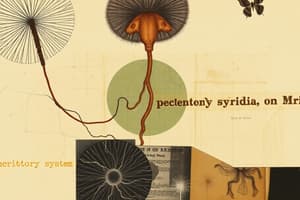Podcast
Questions and Answers
Camels can survive in desert environments by allowing body heat to rise during the day and staying cool at night, having a large body size and fur to insulate, and producing dry feces and ______ urine.
Camels can survive in desert environments by allowing body heat to rise during the day and staying cool at night, having a large body size and fur to insulate, and producing dry feces and ______ urine.
concentrated
The movement of water down its concentration gradient is known as ______.
The movement of water down its concentration gradient is known as ______.
osmosis
Osmotic pressure is the pressure created by osmosis between two solutions separated by a semipermeable membrane. The higher the solute concentration, the lower the ______.
Osmotic pressure is the pressure created by osmosis between two solutions separated by a semipermeable membrane. The higher the solute concentration, the lower the ______.
osmotic pressure
Isotonic solution is a special case where there is no cellular swelling or shrinkage because the solution has the same ______ as the cell.
Isotonic solution is a special case where there is no cellular swelling or shrinkage because the solution has the same ______ as the cell.
Most excretory systems produce a filtrate by pressure-filtering body fluids into ______.
Most excretory systems produce a filtrate by pressure-filtering body fluids into ______.
Human blood has an osmotic concentration of 300 mOsm/L. This makes it a ______ solution.
Human blood has an osmotic concentration of 300 mOsm/L. This makes it a ______ solution.
The transfer of positive charge in the nephron is balanced by the passive transport of ______ out of the tubule.
The transfer of positive charge in the nephron is balanced by the passive transport of ______ out of the tubule.
As salt moves from the filtrate to the interstitial fluid, water follows by ______.
As salt moves from the filtrate to the interstitial fluid, water follows by ______.
The key to producing concentrated urine is the passage of loops of Henle and collecting ducts through tissues of increasing ______.
The key to producing concentrated urine is the passage of loops of Henle and collecting ducts through tissues of increasing ______.
The functional asymmetry between the descending and the ascending limbs of the loop of Henle is characterized by passive diffusion of ______ in the descending limb.
The functional asymmetry between the descending and the ascending limbs of the loop of Henle is characterized by passive diffusion of ______ in the descending limb.
The kidney has a role in maintaining ion balance, including ______, ______, and ______.
The kidney has a role in maintaining ion balance, including ______, ______, and ______.
One of the roles of the kidney in homeostasis is regulating blood pressure by controlling blood volume, thus affecting blood pressure through the regulation of ______.
One of the roles of the kidney in homeostasis is regulating blood pressure by controlling blood volume, thus affecting blood pressure through the regulation of ______.
An injury or severe diarrhea may cause excessive loss of salt and body fluids, reducing blood volume without increasing ______
An injury or severe diarrhea may cause excessive loss of salt and body fluids, reducing blood volume without increasing ______
The RAAS responds to a fall in blood volume and pressure by increasing water and Na+ ______
The RAAS responds to a fall in blood volume and pressure by increasing water and Na+ ______
Atrial Natriuretic Peptide (ANP), released in response to elevated blood pressure, decreases sodium re-absorption leading to increased ______ production
Atrial Natriuretic Peptide (ANP), released in response to elevated blood pressure, decreases sodium re-absorption leading to increased ______ production
ANP inhibits the release of ADH, renin, and ______
ANP inhibits the release of ADH, renin, and ______
Urine formation involves four main processes: filtration, reabsorption, secretion, and ______
Urine formation involves four main processes: filtration, reabsorption, secretion, and ______
Birds, with shorter loops of Henle than mammals, produce uric acid instead of urea and are excellent at conserving ______
Birds, with shorter loops of Henle than mammals, produce uric acid instead of urea and are excellent at conserving ______




